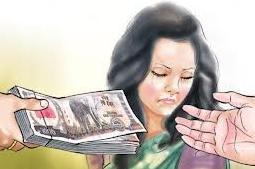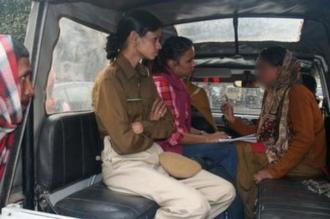Assam: Traffickers’ happy hunting ground
As more and more girls from the northeastern state end up in brothels, stigma awaits those fortunate to be rescued.

Rekharani Barua, 21, is back from the brothel in Mumbai where she spent five years before being rescued.
“But I cannot go back to my native village because my family will not take me,” the petite Assamese teenager said, in what would seem to be replay of the 1981 Bollywood blockbuster “Umrao Jaan”.
Umrao, the titular character played by Indian actress, Rekha, never got to live with her family when she wanted to return to them – her brothers and parents refused to accept the courtesan-dancer because her presence would stigmatise the family.
As scores of Assamese girls are rescued from brothels across India and taken back to their native state, the ‘Umrao Jaan’ syndrome haunts them the most.
“The government will have to create a network of shelter homes for these women because their numbers are growing sharply,” Sumitra Hazarika, a member of Assam’s State Women Commission, said.
Hazarika says the shelter homes must be equipped with vocational guidance centres so that these women can be trained for alternative livelihoods.
“Most of them will not be able to go back home to their families,” Hazarika said. “If we don’t provide them some alternative livelihood and train them for it, they will have no option but to return to the hell police rescued them from.”
But so far that is mere pipe-dream.
Rising figures
A few NGOs run by woman rights activists have tried to help these hapless women rescued from brothels and forced marriages.
The police, which has rescued them, is not trained or equipped to manage their future and have other pressing tasks to perform.
Reacting to reports that trafficking of women from Assam is at an all-time high, the state police have been on an overdrive to track down the trafficked women and the criminal networks responsible for the trafficking.
“We have gone after these rackets, chasing them down all over India,” Dilip Bora, an Assam police official, said. “That is how we managed to rescue many of our women.”
These women had been sold away in brothels or forced into marriages in northern and western Indian states, like Punjab, Gujarat and Haryana where there are more men than women and the rural rich are willing to pay up for a wife.
In recent times, Assam has been in news for separatist violence, ethnic riots and devastating floods that have killed or rendered homeless tens of thousands.
 |
| An awareness programme against human trafficking that aired on a local TV station [Assamese TV Newslive]. |
But now the tea and oil producing state has another very good reason to hit the headlines – women trafficking.
Between 1996 and 2006, 3,184 adult women and 3840 female children were taken away from Assam and sold away in other states, according Assam police records.
That was nearly two women illegally trafficked out of Assam every day on an average.
That seemed to be the case up until the end of the last decade, but the situation has only got worse in the past six to seven years.
In 2009, 759 women and girls were trafficked out of Assam.
But Assam police records say in 2011, at least 1,243 women and girls were trafficked out of Assam – four a day or more on the average.
And that is what has been reported and recorded.
For every case reported, there are many which are not.
Analysts say the high rate of women trafficking from Assam is linked to the violence and the floods that afflict the state.
At the peak of the 2012 riots in western Assam , that pitted the Bodo tribes against Muslims of Bengali origin, nearly a quarter of a million people were displaced.
Preying on the poor
Back in 1996, when riots erupted in western Assam between the Bodos and other non-Bodo communities, again a quarter of a million people were displaced.
In between the two, there have been countless incidents of mass rioting or furious separatist attacks that forced villagers into makeshift camps.
“These displaced people are housed in dreadful makeshift camps where most families live in desperate need of almost everything ,” says Uddipana Goswami, author of Conflict and Reconciliation: Politics of Ethnicity in Assam.
Goswami, whose field research took her to the camps in western Assam, says that the women trafficking syndicates primarily target the poorest among the internally displaced.
That includes camps sheltering villagers in areas hit by floods or river erosion, a regular feature in Assam.
Rekharani was lured away from one such camp for the flood victims six years ago.
|
|
| Thousands remain homeless in Assam |
“The men who took me away offered me a job in a garment factory in Mumbai,” Rekhrani said. “They promised my parents that I would get a good salary but within a week of my arrival in Mumbai, I was sold to the brothel after huge torture.”
Kamrunessa Begum, 16, was taken away from a camp near Bijni in western Assam by the rackets and sold off to a brothel in New Delhi.
That is where her family had taken shelter after attacks by Bodo separatist rebels in 2007.
Three months later, two young men approached them through a local contact, saying she would be taken to New Delhi for a job in a factory.
“My father had been killed and my uncle told my mother this was a chance that should not be missed, so off I went and right into hell,” Kamrunessa recounts.
“Some of the families are so desperate that offers of jobs to their women are welcomed,” Goswami said. “The traffickers use the ruse and take away the women who are no more heard off again.”
In fact, the families are always paid some money as advance for the jobs.
Poor desperate people accept the advance to let their daughters go away, never to see them again.
But while it is possible to track down those in brothel through systematic raids, it is almost impossible to track those sold off into forced marriages.
Only a few of those who have been forced into such marriages have managed to return to their native villages, complaining of torture.
Again, as Anamika Kutum, 23, found to her dismay, her family is unwilling to take her back.
“They want me to go back and live with my husband who forcibly married me and then tortured me all these years,” Kutum said, recounting the regular beatings she faced every time she argued.
“He is my father’s age and he has lots of land, but he is horrible,” says Anamika of her husband whose village is not far from Bhiwani in Haryana , famous for producing boxers.
Determined to fight
Assam’s Social Welfare Minister, Akon Bora, concedes his government’s failure to contain the trafficking but insists they are determined to fight it.
 |
| Two Assamese girls rescued from New Delhi are shown being taken back home by policewoman [Shaktivahini] |
“All district administrations have been told to crack down on trafficking syndicates. We will punish all those connected with trafficking,” Bora said.
But the minister argued prevention may be a better choice.
“We have roped in NGOs to sensitise the poor people in vulnerable areas where trafficking has increased,” Bora said. “We try to dissuade villagers from falling into the trap of the unscrupulous operators.”
But noble intentions regularly lose out to the sinister designs of those looking to prey on the hapless women, some of whom have been used in pornographic films made locally.
In the western Assam town of Kokrajhar, students of a local school showed up in a porn film .
Investigations revealed that the girls had been offered jobs and asked to appear for interviews in a local hotel, served cold drink laced with sedatives, filmed nude and then blackmailed to play the sex act for the films.
The racket was run by a local leader with powerful connections and a particular hotel was used for the filming.
The names of all the trafficked victims in this article have been changed on request to protect their identity.